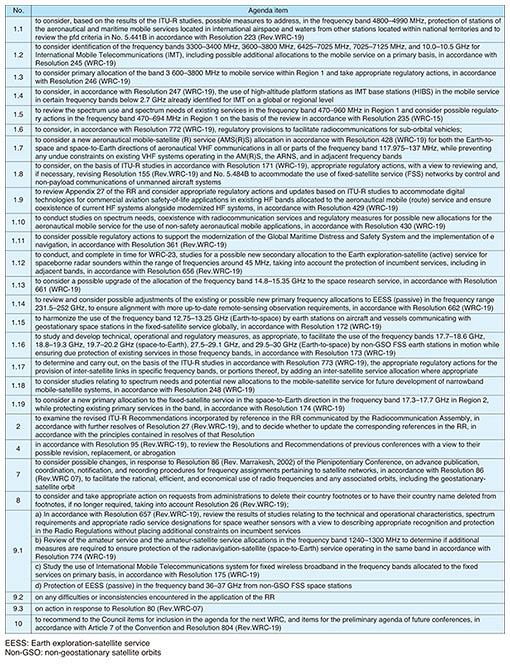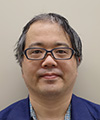 |
|
|
|
|
|
Global Standardization Activities Vol. 18, No. 5, pp. 49–55, May 2020. https://doi.org/10.53829/ntr202005gls ITU World Radiocommunication Conference (WRC-19) ReportAbstractBecause radio waves travel through space across national borders, there can be harmful radio interference between neighboring countries if each country determines how to use radio services on its own, such as in telecommunication and broadcasting. For this reason, the International Telecommunication Union (ITU), the United Nations organization specialized in telecommunication, sets forth the Radio Regulations (RR), a set of international rules for using radio at each frequency and in each region of the world. To revise the RR, concerned parties from all over the world gather at an international conference held about every four years called the ITU World Radiocommunication Conference (WRC). In Japan, the RR revised at the WRC will be reflected in laws such as the Radio Law. This makes the WRC an extremely important conference for the NTT Group, which provides customers with wireless services and wireless systems, such as mobile telecommunication and wireless local area network (LAN), and uses fixed microwave communication systems, satellite communication systems for remote islands, and disaster-response radio systems for its own networks. In this article, we report on the ITU World Radiocommunication Conference 2019 (WRC-19). Keywords: wireless LAN (WLAN), International Mobile Telecommunications (IMT), Radio Regulations (RR) 1. ITU World Radiocommunication Conference 2019 (WRC-19)WRC-19 was held in the city of Sharm El Sheikh, Egypt from October 28 to November 22, 2019. Figure 1 shows the opening ceremony, which was attended by the President of Egypt. About 3300 people from 166 countries participated and discussed agenda items concerning revisions to the Radio Regulations (RR), as shown in Table 1. The Japanese delegation sent about 90 people to participate in discussions, representing the Ministry of Internal Affairs and Communications, as well as telecommunication carriers, broadcasters, manufacturers, research institutes, and other organizations (From NTT Group, this included NTT Access Network Service Systems Laboratories, NTT DOCOMO, NTT Advanced Technology, NTT DATA INSTITUTE OF MANAGEMENT CONSULTING, and NTT Technology Planning Division). The agenda items in blue in Table 1 are mainly related to the NTT Group. NTT Access Network Service Systems Laboratories and NTT Technology Planning Division were in charge of agenda items concerning wireless local area network (LAN) and wireless use by NTT EAST/NTT WEST, while NTT DOCOMO were in charge of agenda items concerning mobile telecommunication and wireless use by NTT DOCOMO. Figure 2 shows the deliberation system of WRC-19. Agenda items related to wireless LAN and mobile telecommunication were discussed at COM 4. For the RR revisions to be approved, they must receive final approval at a plenary session attended by all participating countries.
1.1 Additional frequency allocation to 5-GHz-band wireless LAN for outdoor useDiscussions were held regarding agenda item 1.16, primarily concerning regulatory measures for wireless access systems including wireless LAN in the 5-GHz band (5.15–5.925 GHz), meaning studies of the revisions to the RR to expand the use of 5-GHz band wireless LAN. Studies to enable outdoor use of wireless LAN and higher transmission power in the 5.2-GHz band (5.15–5.25 GHz) are especially relevant to Japan. In the RR, use of wireless LAN indoors and outdoors in the 5.6-GHz band was already permitted under certain conditions, but the 5.2-GHz band was restricted to indoor use only. Maximum equivalent isotropically radiated power (EIRP) was allowed up to 1 W in the 5.6-GHz band, while limited to 200 mW in the 5.2-GHz band. The reason for this was that the 5.2-GHz band was already in use internationally by other systems, such as satellite communications, so there was concern that there could be harmful radio interference if wireless LAN was used outdoors. In Japan, the Information and Communications Council conducted technical studies with participation from NTT Access Network Service Systems Laboratories to discuss the possibility of sharing the 5.2-GHz band with satellite telecommunications under outdoor use of wireless LAN. One purpose of these studies is to facilitate the provision of wireless LAN services at venues for international sport competitions to be held in Tokyo. As a result of these studies, under the condition of increasing the maximum transmission power to the same level as the 5.6-GHz band that can already be used outdoors, it can be shared without harmful interference by limiting the number of wireless LAN access points used outdoors and limiting the elevation angle of the antenna. In 2018, Japanese laws and regulations were amended (wireless LAN access points for outdoor use were required to be registered to limit the number of access points, etc.), allowing for trial use of the 5.2-GHz band outdoors. NTT Broadband Platform and others are using the 5.2-GHz band outdoors in addition to the 5.6-GHz band. At WRC-19, NTT Access Network Service Systems Laboratories took the lead, calling for the outdoor use of 5.2-GHz band wireless LAN and high transmission power under conditions equal to or higher than those in Japan. They succeeded in revising the RR by holding discussions until the last day of the conference with the countries using this band for satellite telecommunications. As a result, wireless LAN will continue to be available outdoors in the 5.2-GHz band under certain conditions, in addition to the 5.6-GHz band in Japan. Details of this matter will be published in the June 2020 issue of this journal. 1.2 Additional allocation to mobile telecommunicationsIn Japan, the 3.7-, 4.5-, and 28-GHz bands have already been allocated to mobile telecommunication operators as fifth-generation mobile communication system (5G) frequencies in April 2019, and 5G is being introduced in other countries as well. From this background, agenda item 1.13 included studies of frequencies in the submillimeter and millimeter wave bands for the future development of International Mobile Telecommunications (IMT), which is to say studies of the revisions to the RR to add frequencies for mobile telecommunications such as 5G. At WRC-19, NTT DOCOMO and other mobile telecommunication operators and parties who are involved in existing wireless systems in Japan, such as earth exploration satellites, participated in discussions of these systems, which lasted from early morning to late at night for several days. Almost exactly as requested by Japan, the RR were successfully revised to add a 15.75-GHz bandwidth of new frequencies for IMT: 24.25–27.5, 37–43.5, 45.5–47, 47.2–48.2, and 66–71 GHz (45.5–47 GHz is not applicable to Japan). Of these bands, 26.6–27 and 39.5–43.5 GHz are undergoing technical studies by the Information and Communications Council in preparation for the next allocation of frequencies for 5G in Japan. The details of this topic will be published in the July 2020 issue of NTT DOCOMO Technical Journal. 1.3 Other agenda itemsWith regard to other agenda items, we focused on those that were mainly related to the NTT Group and acted to avoid the harmful effects on existing NTT Group wireless systems. No amendments to the RR agreed upon at WRC-19 have any harmful effects on wireless systems for the NTT Group. 1.4 Agenda items of ITU World Radiocommunication Conference 2023 (WRC-23)At WRC-19, the agenda items for the WRC-23 were discussed and decided upon, as shown in Table 2. There is no agenda item concerning wireless LAN. With regard to mobile telecommunications, agenda item 1.2 is to consider IMT identification in multiple candidate frequency bands. Among the candidate frequency bands, the 7.025–7.125-GHz band is considered for IMT identification worldwide, which concerns Japan. Other candidate frequency bands are considered for IMT identification for the regions other than Asia-Pacific, and Japan is not involved. Agenda item 1.4 is to consider High Altitude Platform Station (HAPS) as IMT Base Stations (HIBS) in the frequency bands specified for IMT in the 2.7-GHz band or lower. It is aimed at mounting IMT base stations on high-altitude flying vehicles in the stratosphere to provide services of IMT to ground areas.
2. ITU Radiocommunication Assembly 2019 (RA-19)Prior to WRC-19, RA-19 was held in Sharm El Sheikh, Egypt from October 21 to 25, 2019. RA is a general meeting of ITU-Radiocommunication Sector (ITU-R) held about every four years, the same as the WRC. At the RA, the chair and vice-chair of the Study Groups (SGs) of ITU-R are appointed, and study items are approved. About 511 people from 88 countries participated in RA-19, including 36 people from Japan, with representatives from the Ministry of Internal Affairs and Communications. As shown in Fig. 3, the chair and vice-chair of various SGs were appointed, and from NTT Group, Dr. Hiroyuki Atarashi of NTT DOCOMO was appointed as one of the SG 5 vice-chairs responsible for study on terrestrial services including fixed, mobile, and radiodetermination systems. The study results from each SG will be published as recommendations or reports from ITU-R and will be referred to during the WRC discussions.
3. Future activitiesIn preparation for WRC-23, NTT aims to add more frequencies for wireless systems for the NTT Group and protect existing NTT Group wireless systems from harmful radio interference. To that end, we will continue our work at ITU-R, WRC preparatory meetings in the Asia-Pacific region, and related meetings in Japan. |
|

















